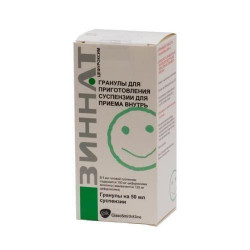



 All payments are encrypted via SSL
All payments are encrypted via SSL
 Full Refund if you haven't received your order
Full Refund if you haven't received your order
Bottle for the preparation of 50 ml of suspension.
Zinnat is a II generation cephalosporin antibiotic for oral administration. Bactericidal effect, violates the synthesis of the cell wall of bacteria. It has a wide spectrum of action.
Resistant to most beta-lactamase.
Zinnatathighly active againstaerobic gram-positive bacteria:Staphylococcus aureus, Staphylococcus epidermidis (including strains that are resistant to penicillins and with the exception of rare methicillin-resistant strains), Streptococcus pyogenes, Streptococcus pneumoniae, Streptococcus group B (Streptococcus agalactiae, etc., in line with a hint of a hint, in line with a hint of a hint, in a group of people who are resistant to the disease).aerobic gram-negative bacteria: Escherichia coli, Klebsiella spp., Proteus mirabilis, Providencia spp., Proteins, all of which have a look at the tomb of the Holy See and not producing penicillinase), Neisseria meningitidis, Salmonella spp.;anaerobic gram-positive bacteria: Peptococcus spp., Peptostreptococcus spp., Clostridium spp., Propionibacterium spp.;anaerobic gram-negative bacteria: Bacteroides spp, Fusobacterium spp.; alsoactive against Borrelia burgdorferi.
To cefuroximeare resistant Clostridium difficile, Pseudomonas spp., Campylobacter spp., Acinetobacter calcoaceticus, Listeria monocytogenes, methicillin-resistant strains of Staphylococcus aureus, methicillin-resistant strains of Staphylococcus epidermidis, Legionella spp.
In vitro studies have shown that the combination of cefuroxime with antibiotics from the group of aminoglycosides has an additive effect, and in some cases synergism.
Treatment of infectious and inflammatory diseases caused by microorganisms sensitive to the drug:
Hypersensitivity to the antibiotics of the cephalosporins group.
Carefully used in the first trimester of pregnancy and lactation.
Children under the age of 12 You can prescribe the drug in the form of a suspension.
The average dose for most infections is 125 mg (1 scoop of suspension or 1 tab.) 2 times a day.
With severe infections or otitis media in children aged 2 years and older the average dose is 250 mg 2 times a day.
In case of mild to moderate infectious diseases a single dose set at the rate of 10 mg / kg body weight.
The duration of the drug is 5-10 days.
The drug is recommended to be taken after meals.
Gastrointestinal: nausea, vomiting, diarrhea; perhaps a temporary increase in the activity of liver enzymes (ALT, AST, LDH), jaundice; Cases of pseudomembranous colitis are described.
Hemic and lymphatic: hemolytic anemia, eosinophilia, neutropenia, thrombocytopenia, leukopenia (sometimes pronounced).
Allergic reactions: skin rash, pruritus, urticaria, fever, erythema multiforme, Stevens-Johnson syndrome, toxic epidermal necrolysis, serum sickness; in isolated cases - anaphylaxis.
From the side of the central nervous system: headache.
Other: Coombs' positive reaction.
With prolonged use of Zinnat, enhanced growth of resistant microorganisms (Candida, Enterococci, Clostridium difficile) is possible, which may require cessation of treatment.
When diarrhea appears on the background of the use of antibiotics, incl. Zinnat, it should be borne in mind the possibility of pseudomembranous colitis.
When treated with Zinnat Lyme disease, the Jarish-Gersheimer reaction is sometimes noted. This reaction is a direct consequence of the bactericidal action of Zinnat on the causative agent of the disease - the spirochete Borrelia burgdorferi. Patients need to be explained that this is a frequent and common, spontaneous passing of a consequence of Lyme disease antibiotics treatment.
Simultaneous administration of cefuroxime and probenecid leads to an increase in AUC of cefuroxime by 50%.
Store at a temperature not higher than 25 ° С.
Zinnat